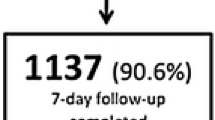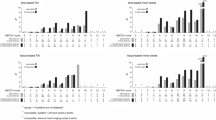Summary
Several studies have indicated that stroke survivors with multiple lesions or with larger lesion volumes have a higher risk of stroke recurrence. However, the relationship between lesion locations and stroke recurrence is unclear. We conducted a prospective cohort study of first-ever ischemic stroke survivors who were consecutively enrolled from January 2010 to December 2015. Stroke recurrence was assessed every 3 months after post-discharge via telephone interviews by trained interviewers. Lesion locations were obtained from hospital-based MRI or CT scans and classified using two classification systems that were based on cerebral hemisphere or vascular territory and brain anatomical structures. Flexible parametric survival models using the proportional hazards scale (PH model) were used to analyze the time-to-event data. Among 633 survivors, 63.51% (n=402) had anterior circulation ischemia (ACI), and more than half of all ACIs occurred in the subcortex. After a median follow-up of 2.5 years, 117 (18.48%) survivors developed a recurrent stroke. The results of the multivariate PH model showed that survivors with non-brain lesions were at higher risk of recurrence than those with right-side lesions (HR, 2.79; 95%CI, 1.53, 5.08; P=0.001). There was no increase in risk among survivors with left-side lesions (HR, 0.97; 95%CI, 0.53, 1.75; P=0.914) or both-side lesions (HR, 1.24; 95%CI, 0.75, 2.07; P=0.401) compared to those with right-side lesions. Additionally, there were no associations between stroke recurrence and lesion locations that were classified based on vascular territory and brain anatomical structures. It was concluded that first-ever ischemic stroke survivors with non-brain lesion had higher recurrence risk than those with right-side lesion, although no significant associations were found when the lesion locations were classified by vascular territory and brain anatomical structures.
Similar content being viewed by others
References
Lozano R, Naghavi M, Foreman K, et al. Global and regional mortality from 235 causes of death for 20 age groups in 1990 and 2010: a systematic analysis for the Global Burden of Disease Study 2010. Lancet, 2012,380(9859):2095–2128
Murray CJL, Vos T, Lozano R, et al. Disability-adjusted life years (DALYs) for 291 diseases and injuries in 21 regions, 1990–2010: a systematic analysis for the Global Burden of Disease Study 2010. Lancet, 2012,380(9859):2197–2223
Yang G, Wang Y, Zeng Y, et al. Rapid health transition in China, 1990–2010: findings from the Global Burden of Disease Study 2010. Lancet, 2013,381(9882):1987–2015
Tu F, Tokunaga S, Deng Z, et al. Analysis of hospital charges for cerebral infarction stroke inpatients in Beijing, People’s Republic of China. Health Policy, 2002,59(3):243–256
Coull AJ, Rothwell PM. Underestimation of the early risk of recurrent stroke evidence of the need for a standard definition. Stroke, 2004,35(8):1925–1929
Kernan WN, Ovbiagele B, Black HR, et al. Guidelines for the prevention of stroke in patients with stroke and transient ischemic attack a guideline for healthcare professionals from the American Heart Association/American Stroke Association. Stroke, 2014,45(7):2160–2236
Hong K-S, Yegiaian S, Lee M, et al. Declining stroke and vascular event recurrence rates in secondary prevention trials over the past 50 years and consequences for current trial design. Circulation, 2011,123(19):2111–2119
Lee M, Saver JL, Liao HW, et al. Pioglitazone for Secondary Stroke Prevention. Stroke, 2017,48(2):388–393
Mai H, Xia J, Wu Y, et al. Clinical presentation and imaging characteristics of occult lung cancer associated ischemic stroke. J Clin Neurosci, 2015,22(2):296–302
Nezu T, Mukai T, Uemura J, et al. Multiple Infarcts Are Associated With Long-Term Stroke Recurrence and All-Cause Mortality in Cryptogenic Stroke Patients. Stroke, 2016,47(9):2209–2215
Pan Y, Meng X, Jing J, et al. Association of multiple infarctions and ICAS with outcomes of minor stroke and TIA. Neurology, 2017,88(11):1081–1088
Asdaghi N, Hameed B, Saini M, et al. Acute perfusion and diffusion abnormalities predict early new MRI lesions 1 week after minor stroke and transient ischemic attack. Stroke, 2011,42(8):2191–2195
Etherton MR, Wu O, Rost NS. Recent Advances in Leukoaraiosis: White Matter Structural Integrity and Functional Outcomes after Acute Ischemic Stroke. Curr Cardiol Rep, 2016,18(12):123–135
Bentley P, Kumar G, Rinne P, et al. Lesion locations influencing baseline severity and early recovery in ischaemic stroke. Eur J Neurol, 2014,21(9):1226–1232
Braun KP, Bulder MM, Chabrier S, et al. The course and outcome of unilateral intracranial arteriopathy in 79 children with ischaemic stroke. Brain, 2009,132(Pt 2):544–557
Hier DB, Foulkes MA, Swiontoniowski M, et al. Stroke recurrence within 2 years after ischemic infarction. Stroke, 1991,22(2):155–161
Roquer J, Rodriguez-Campello A, Cuadrado-Godia E, et al. Acute brain MRI-DWI patterns and stroke recurrence after mild-moderate stroke. J Neurol, 2010,257(6):947–953
Liu J, Liu W. Stroke recurrence analysis of symptomatic middle cerebral artery occlusive disease. Chin J Cerebrovasc Dis, 2004,1(9):401–404
Saeki S, Ogata H, Hachisuka K, et al. Association between location of the lesion and discharge status of ADL in first stroke patients. Arch Phys Med Rehabil, 1994,75(8):858–860
Beloosesky Y, Streifler J, Burstin A, et al. The importance of brain infarct size and location in predicting outcome after stroke. Age Ageing, 1995,24(6):515–518
Keselman B, Gdovinova Z, Jatuzis D, et al. Safety and Outcomes of Intravenous Thrombolysis in Posterior Versus Anterior Circulation Stroke: Results From the Safe Implementation of Treatments in Stroke Registry and Meta-Analysis. Stroke, 2020,51(3):876–882
Hou L, Du X, Chen L, et al. Exercise and quality of life after first-ever ischaemic stroke: a two-year follow-up study. Int J Neurosci, 2018,128(6):540–548
Investigators WMPP. The world health organization monica project (monitoring trends and determinants in cardiovascular disease): A major international collaboration. J Clin Epidemiol, 1988,41(2):105–114
Bilic I, Dzamonja G, Lusic I, et al. Risk factors and outcome differences between ischemic and hemorrhagic stroke. Acta Clin Croat, 2009,48(4):399–403
Hou LS, Du XD, Li JJ, et al. Long-term trends and predictors of smoking behaviors among men following first-ever ischemic stroke. J Huazhong Univ Sci Technolog Med Sci, 2017,37(3):446–452
Kalinowski A, Humphreys K. Governmental standard drink definitions and low-risk alcohol consumption guidelines in 37 countries. Addiction, 2016,111(7):1293–1298
Karve S, Cleves MA, Helm M, et al. Good and poor adherence: optimal cut-point for adherence measures using administrative claims data. Curr Med Res Opin, 2009,25(9):2303–2310
Bijlsma MJ, Janssen F, Hak E. Estimating time-varying drug adherence using electronic records: extending the proportion of days covered (PDC) method. Pharmacoepidemiol Drug Saf, 2016,25(3):325–332
Zhou BF. Predictive values of body mass index and waist circumference for risk factors of certain related diseases in Chinese adults-study on optimal cut-off points of body mass index and waist circumference in Chinese adults. Biomed Environ Sci, 2002,15(1):83–96
Kay R, Wong KS, Perez G, et al. Dichotomizing stroke outcomes based on self-reported dependency. Neurology, 1997,49(6):1694–1696
Royston P, Parmar MK. Flexible parametric proportional-hazards and proportional-odds models for censored survival data, with application to prognostic modelling and estimation of treatment effects. Stat Med, 2002,21(15):2175–2197
James ND, de Bono JS, Spears MR, et al. Abiraterone for Prostate Cancer Not Previously Treated with Hormone Therapy. N Engl J Med, 2017,377(4):338–351
Stringhini S, Carmeli C, Jokela M, et al. Socioeconomic status and the 25 × 25 risk factors as determinants of premature mortality: a multicohort study and meta-analysis of 1·7 million men and women. Lancet, 2017,389(10075):1229–1237
Lam CSP, Hall M, Dondo TB, et al. Multimorbidity and survival for patients with acute myocardial infarction in England and Wales: Latent class analysis of a nationwide population-based cohort. PLOS Med, 2018,15(3):e1002501–e1002518
Song H, Fang F, Tomasson G, et al. Association of Stress-Related Disorders With Subsequent Autoimmune Disease. JAMA, 2018,319(23):2388–2400
Royston P, Lambert PC. Flexible parametric survival analysis using Stata: beyond the Cox model. Stata Press Books, 2011.
Niemi ML, Laaksonen R, Kotila M, et al. Quality of life 4 years after stroke. Stroke, 1988,19(9):1101–1107
de Haan RJ, Limburg M, Van der Meulen JHP, et al. Quality of Life After Stroke: Impact of Stroke Type and Lesion Location. Stroke, 1995,26(3):402–408
Bickerton WL, Demeyere N, Francis D, et al. The BCoS cognitive profile screen: Utility and predictive value for stroke. Neuropsychology, 2015,29(4):638–648
Kim JT, Park MS, Choi KH, et al. Clinical Outcomes of Posterior Versus Anterior Circulation Infarction With Low National Institutes of Health Stroke Scale Scores. Stroke, 2017,48(1):55–62
Brian L, Megan MS-S, Rani J, et al. Executive Function Following Child Stroke: The Impact of Lesion Location. J Child Neurol, 2010,26(3):279–287
Jung JM, Kang DW, Yu KH, et al. Predictors of recurrent stroke in patients with symptomatic intracranial arterial stenosis. Stroke, 2012,43(10):2785–2787
Famakin BM, Chimowitz MI, Lynn MJ, et al. Causes and Severity of Ischemic Stroke in Patients With Symptomatic Intracranial Arterial Stenosis. Stroke, 2009,40(6):1999–2003
Robinson RG, Jorge RE. Post-stroke depression: a review. Am J Psychiatry, 2015,173(3):221–231
MacIntosh BJ, Edwards JD, Kang M, et al. Post-stroke Fatigue and Depressive Symptoms Are Differentially Related to Mobility and Cognitive Performance. Front Aging Neurosci, 2017,9:343–349
Braun KP, Bulder MM, Chabrier S, et al. The course and outcome of unilateral intracranial arteriopathy in 79 children with ischaemic stroke. Brain, 2009,132(2):544–557
Flossmann E, Rothwell PM. Prognosis of vertebrobasilar transient ischaemic attack and minor stroke. Brain, 2003,126(Pt 9):1940–1954
Chatterjee T, Gupta N, Choudhry VP, et al. Prediction of ischemic stroke in young Indians: is thrombophilia profiling a way out? Blood Coagul Fibrinolysis, 2013,24(4):449–453
Ren XM, Qiu SW, Liu RY, et al. White Matter Lesions Predict Recurrent Vascular Events in Patients with Transient Ischemic Attacks. Chin Med J, 2018,131(2):130–136
Bailey RR. Lifestyle Modification for Secondary Stroke Prevention. Am J Lifestyle Med, 2016,12(2):140–147
Khatri P, Abruzzo T, Yeatts SD, et al. Good clinical outcome after ischemic stroke with successful revascularization is time-dependent. Neurology, 2009,73(13):1066–1072
Uyttenboogaart M, Stewart RE, Vroomen PCAJ, et al. Optimizing Cutoff Scores for the Barthel Index and the Modified Rankin Scale for Defining Outcome in Acute Stroke Trials. Stroke, 2005,36(9):1984–1987
Author information
Authors and Affiliations
Corresponding authors
Ethics declarations
The authors declare that they have no conflict of interest.
Additional information
This study was funded by the National Natural Science Foundation of China (No. 81673273 and No. 30600511).
Rights and permissions
About this article
Cite this article
Yan, Pj., Hou, Ls., Li, Me. et al. Associations between Lesion Locations and Stroke Recurrence in Survivors of First-ever Ischemic Stroke: A Prospective Cohort Study. CURR MED SCI 40, 708–718 (2020). https://doi.org/10.1007/s11596-020-2240-y
Received:
Accepted:
Published:
Issue Date:
DOI: https://doi.org/10.1007/s11596-020-2240-y




